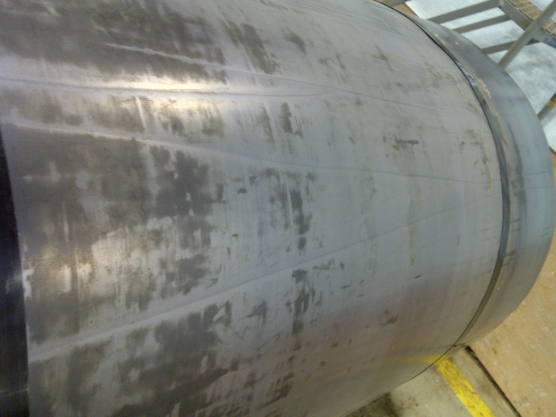
Posted on Sunday, September 28, 2025
Roll forming machines are the backbone of the metal fabrication industry, enabling high-speed, precise, and consistent shaping of metal sheets into profiles such as roofing panels, wall cladding, purlins, and structural components. While these machines are highly efficient, their performance is heavily dependent on the quality of the raw material—namely, the metal coils fed into the system. Poor-quality or “bad” coils can severely impact production, product quality, and even the lifespan of the machine itself. In this blog, we’ll explore the causes, effects, and solutions for dealing with bad coils in roll forming operations.
A “bad coil” refers to a metal coil that exhibits defects or inconsistencies that can negatively affect roll forming operations. These defects can occur during manufacturing, handling, storage, or transportation and may include:
Surface defects: scratches, dents, rust, or oil stains.
Dimensional inconsistencies: uneven thickness, wavy edges, or incorrect width.
Mechanical issues: poor flatness, camber, edge cracks, or internal stress.
Material composition problems: improper alloy content or hardness variations.
Even coils that appear visually acceptable may hide internal stress or hardness variations that cause issues during forming.
Understanding the root causes of bad coils helps in preventing or minimizing their impact:
Manufacturing Defects:
Poor rolling or annealing processes can leave internal stresses or uneven thickness.
Inconsistent alloy composition can affect formability.
Storage and Handling:
Exposure to moisture or improper storage conditions can lead to rust, corrosion, or surface staining.
Mishandling during transport can create dents, scratches, or coil set deformation.
Transportation Damage:
Poorly secured coils can shift during shipping, causing edge damage or coil deformation.
Sudden impacts can create internal cracks or flatness issues.
Aging or Long-Term Storage:
Older coils may experience surface oxidation or slight dimensional changes over time.
Coils stored improperly for long periods may develop “coil memory” causing curling during uncoiling.
Using defective coils can lead to significant operational and financial problems:
Misalignment, jamming, or tearing of material can halt production lines.
Operators may spend extra time adjusting feeds or trimming edges, reducing efficiency.
Inconsistent thickness or camber results in warped or non-uniform profiles.
Surface defects transfer directly to finished products, reducing market value.
Hard spots or inconsistent metal thickness can strain rollers, bearings, and gearboxes.
Coils with internal stress may “spring back,” causing repeated misfeeds and potential damage to forming stations.
Scrap rates increase due to defective products.
More frequent maintenance and replacement of worn components add to expenses.
Coil defects can cause unexpected material behavior, posing risks to operators.
Misfeeds and material breaks may lead to accidents in high-speed lines.
Early identification of problematic coils can save significant time and cost:
Visual Inspection: Look for rust, scratches, dents, or oil stains.
Dimensional Check: Measure thickness, width, and flatness before loading.
Uncoiling Test: Uncoil a small portion to detect edge cracks, camber, or curling.
Hardness and Stress Testing: For high-precision products, checking hardness or residual stress may be necessary.
Minimizing the impact of bad coils requires a combination of prevention, early detection, and corrective action:
Work with reputable suppliers with strict quality control standards.
Request certificates of compliance, including thickness tolerance, alloy composition, and surface quality.
Store coils in a dry, temperature-controlled environment to prevent rust or corrosion.
Use coil racks or padded surfaces to prevent deformation and scratches.
Always inspect and measure coils before feeding them into the machine.
Use coil leveling equipment to correct minor flatness or camber issues.
Adjust forming rollers, guides, and tension settings to accommodate minor coil variations.
Regularly inspect and maintain roll forming components to handle slight inconsistencies without damage.
Train operators to recognize problematic coils and take corrective action immediately.
Ensure staff follow safe handling and uncoiling procedures to prevent additional coil damage.
Coil conditioning systems, such as levelers or straighteners, can reduce internal stresses and flatten slightly warped coils before forming.
| Symptom | Possible Cause | Recommended Solution |
|---|---|---|
| Scratches or dents on profiles | Surface damage during handling | Inspect coils; use padded storage; adjust rollers |
| Warped or wavy profiles | Coil camber or uneven thickness | Pre-level coil; adjust forming speed/tension |
| High scrap rates | Internal stress or inconsistent material | Test coils; source from quality supplier |
| Roller damage or premature wear | Hard spots or thickness variations | Inspect coils; maintain and adjust rollers |
| Misfeeds or line stoppages | Edge cracks or coil deformation | Pre-check coil; straighten edges; train operators |
The quality of metal coils is a critical factor in the performance and longevity of roll forming machines. Bad coils can cause production delays, higher scrap rates, poor product quality, and even machine damage. However, with proper sourcing, inspection, handling, and machine adjustment practices, most coil-related problems can be mitigated.
Investing in quality coils, training operators, and using pre-processing equipment not only protects your roll forming machines but also ensures consistent, high-quality products that keep your operations running smoothly.

32/1000 Box Profile Roll Forming Machine – Complete Guide & Specifications
Posted on Sunday, November 16, 2025
High-performance 32/1000 box profile roll forming machine for roofing and cladding. Full specifications, profiles, applications, pricing

PBR / R-Panel Roll Forming Machine – Complete Guide & Specifications
Posted on Sunday, November 16, 2025
PBR / R-Panel roll forming machine for roofing and wall cladding. Full specs, profiles, applications, pricing, and global buying guide. Built to order.

Posted on Sunday, November 16, 2025
How to Diagnose and Fix the Hidden Electrical Problems That Cause Downtime
Copyright 2025 © Machine Matcher.